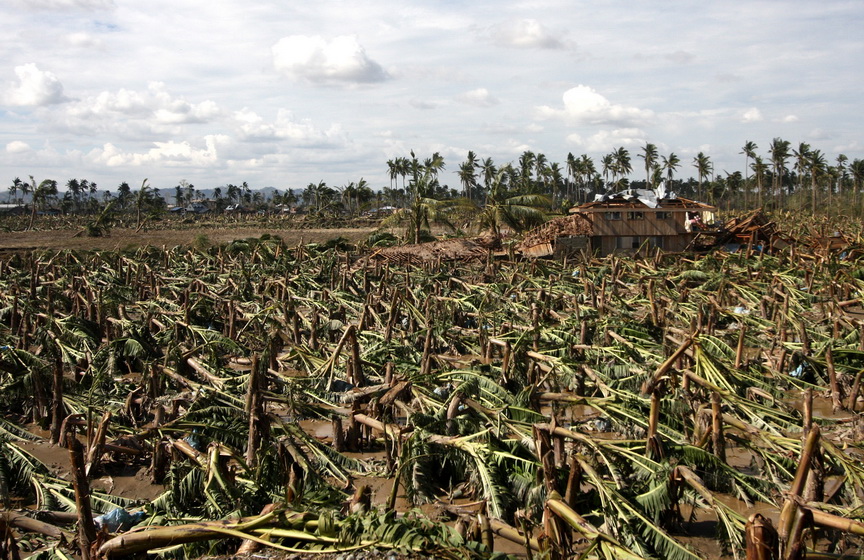 Strong winds brought by Typhoon Pablo on Tuesday destroy hundreds of hectares of banana plantations in Compostela town, Compostela Valley Province. Mindanews Photo by Ruby Thursday More
Strong winds brought by Typhoon Pablo on Tuesday destroy hundreds of hectares of banana plantations in Compostela town, Compostela Valley Province. Mindanews Photo by Ruby Thursday More
DAVAO CITY (MindaNews / 19 Dec) – Small banana farmers in the Davao Region suffered a “double whammy” of devastation brought by typhoon “Pablo” and the financial crisis in rehabilitating their wiped out farms.
Ernesto Dilodilo, assistant manager of the Federation of Agrarian Reform Beneficiaries Banana-based Cooperative of Davao (Fedco), said in an interview Tuesday small banana farmers suffer the worst as they have been indebted for so many years before the calamity wiped out their main source of livelihood.
Affected farms comprise about 13,797 hectares (ha), mostly in Compostela Valley and Davao del Norte, with potential revenue loss of P7.7 billion as of December 10, according to an industry briefer prepared by Pilipino Banana Growers and Exporters Association, Inc. (PBGEA).
In a hectare of land, an average of 3,500 boxes of Cavendish bananas can be produced with a buying price of $4 ($1=P40) per box.
PBGEA estimates the total rehabilitation cost at P6.9 billion, considering that each hectare needs P500,000, which will take nine months to a year.
Dilodilo cited a Fedco member-cooperative, Manuel Guianga Banana Cluster Cooperative (MGBCC), whose 14-hectare farm of highland Cavendish bananas in New Corella, Davao del Norte was totally wiped out by Pablo.
The MGBCC, which also has a lowland Cavendish banana farm in the city, needs P4.9 million for the rehabilitation.
He said it was reported that some workers of the cooperative were temporarily laid off.
Dilodilo said the cooperative had relied on its harvest come February to pay off this year’s loss due to China’s refusal to accept bananas for quarantine and phytosanitary measures.
The Philippine banana industry reportedly had an oversupply of export Cavendish bananas supposed to be shipped for China, losing at least P3 billion since March.
While farmers cannot pay for their previous loans, they have to avail another loan to rehabilitate their farms so that they can pay for their earlier loans, Dilodilo explained.
Collateral
Some farmers, who used their land as collateral for their loans, he continued, lost their lands to the banks for not being able to keep up with their financial obligations.
Others who were agrarian reform beneficiaries had their lands revoked by the government for failing to pay the amortization, he said.
Two Fedco member-cooperatives in Asuncion, Davao del Norte with a total land area of 220.46 ha were also affected by 40 percent, losing about 770,000 boxes of Cavendish bananas.
Stephen Antig, PBGEA executive director, said in an interview the government should step in and help Pablo-hit small banana growers rehabilitate their farms.
He cited that agrarian reform beneficiaries are some of the hardest hit, adding that the Department of Agrarian Reform has to provide assistance.
“If the farmers could not cope with their loss, they cannot pay the land amortization that the government provided them,” Antig said in Cebuano.
He added that such government program of giving out lands fails if the farmers cannot improve their lives.
Antig pointed out that some members of the industry have existing loans with banks and other financial institutions.
That’s why, he added, although banana farmers have started clearing their lands from the devastation, they cannot have an immediate rehabilitation unless the government helps them.
Antig said if a farmer asks for another loan from the same bank, it’s possible that the bank would hesitate granting him or her, adding, “Wala pa gani naimpas utang na pud.” (The loan has not been fully paid yet, and borrowing money again.)
Also willing
Agriculture Secretary Proceso Alcala earlier said the Land Bank of the Philippines allots P2.1-billion worth of loan for banana farmers affected by the typhoon.
Citing that the amount is not enough for the estimated rehabilitation cost in Davao alone, Antig said the Development Bank of the Philippines (DBP) is also willing to finance the rehabilitation of Pablo-stricken banana farms.
But he added that the rate of interest has not been discussed yet during the PBGEA’s initial meeting with the DBP.
He cited that some financial institutions, especially those that are already exposed to the banana industry, intended to extend loans for the rehabilitation.
Personally, Antig said, these banks will not think twice to help as they already have financed some banana growers because they know that if they would not help them, it would also be difficult for the banks to recover previous loans.
He mentioned that the Department of Agriculture should provide more assistance other than the loans offered by the Land Bank like the Comprehensive Agricultural Loan Fund (CALF), which had been implemented since two or three years ago.
Still poor
Small banana farmers have remained poor since 40 to 60 years ago, despite the fact that the industry is earning dollars, Dilodilo told MindaNews.
These income in dollars do not reach the grassroots level, the small growers, he said.
He cited that banana growers are always losing as the average production cost of a 13-kilo box of bananas is $3 and the buying price set in the contract with multinational banana exporters is also at $3 or $3.20.
However, Fedco, being a cooperative, sets a buying price as high as $4.65 per box for bananas shipped to Japan.
“Being in a cooperative is an advantage for small growers,” he said, noting that aside from the high buying price, members get a share from the 70 percent of Fedco’s net income.
The government has to step in so that small farmers will not be exploited by multinational companies, he stressed.
“The farmers will always be indebted from banks and other financial institutions, aside from debts spent for sustenance of their food and education of their children,” he added.
Antig cited that Trade and Industry Secretary Gregory Domingo said the department will help the banana industry, considering its big contribution to the economy.
At least 1.6 million people are counting on the industry in the country, according to Antig.
He said the banana industry has about 80,000 ha with an average of four direct and indirect employees per hectare. Each employee will have at least five dependents.
“Imagine how many people are depending on banana plantations for their livelihood,” he told MindaNews.
Shortage
The exact shortage of banana supply for export will be determined during the peak season (March-May) next year, Antig said.
Considering that the rehabilitation period will take up to one year, no supply will be expected from those typhoon-hit areas that provide 20 percent of the entire production, he added.
However, the volumes to be produced by next year that are intended for China will be used to augment the supply for the traditional ones, such as Japan, Korea and New Zealand.
Antig said Middle East and China will not be prioritized while the rehabilitation of devastated farms is ongoing, adding that tapping supplies from others regions may also be considered should the shortage increase.
The region has pending commitments to some international markets, he said.
However, they will understand due to the calamity although they might be buying from other countries in the meantime, he added. (Lorie Ann A. Cascaro / MindaNews)
